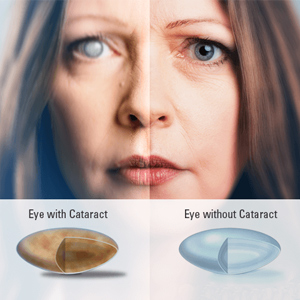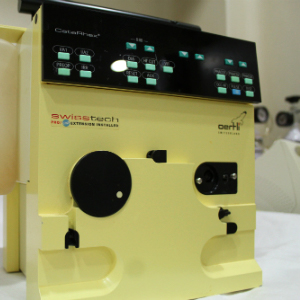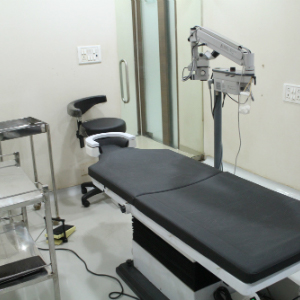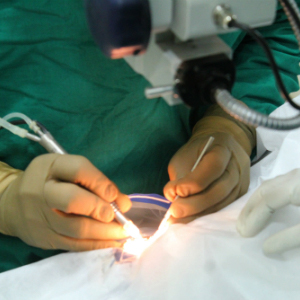
At Khandwala Eye Hospital You will be cared by an excellent Ophthalmologists for both your preoperative and postoperative visits. Here, Laser Vision Correction includes a pre-procedure visit and a thorough examination, the procedure itself, and all follow-up care to ensure the best possible results.
What is a Cataract Eye Surgery
Experience the freedom of clear Vision..
A cataract is a clouding of the lens inside the eye which leads to a decrease in vision. It is the most common cause of blindness and is conventionally treated with surgery. Visual loss occurs because opacification of the lens obstructs light from passing and being focused on the retina at the back of the eye.It is most commonly due to aging, but has many other causes. Over time, yellow-brown pigment is deposited in the lens, and this, together with disruption of the lens fibers, reduces the transmission of light and leads to visual problems.
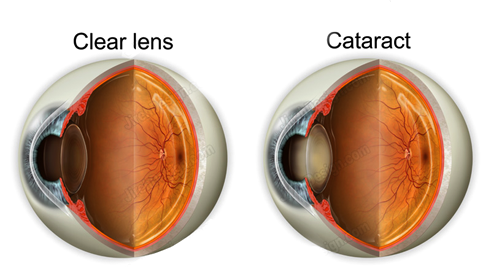
Clouding of the Lens
At Khandwala's Eyecare, we provide cataract lens replacement surgery. Several types of intraocular lens
( IOL ) implants are available to help you enjoy improved vision.
 Most patients are pleasantly surprised to find that their vision begins to improve a few hours after surgery. They may even find their vision better than ever. You will however need to wear glasses for reading and other activities. During the healing period, there may be some restrictions on strenuous activities.But most of our patients have returned to their normal lifestyle immediately.
Most patients are pleasantly surprised to find that their vision begins to improve a few hours after surgery. They may even find their vision better than ever. You will however need to wear glasses for reading and other activities. During the healing period, there may be some restrictions on strenuous activities.But most of our patients have returned to their normal lifestyle immediately.
A Walkthough Video of Cataract Procedure..
Cataract is a common eye condition that affects millions of people.
Everyone will get cataracts if they live long enough. Cataracts can cause blurriness, poor night vision, or glare that gradually worsens if the cataracts are not removed.If cataract surgery is intended to correct distance vision in both eyes, and if one has normal depth perception, things should be fine following surgery. That said, many patients choose to have multifocal lens implants or to do monovision (having one eye set for near vision and the other for distance), and that could influence depth perception for near work. Regardless, details regarding expected outcomes should be discussed before surgery with the ophthalmologist.
Types of Cataract Procedures..
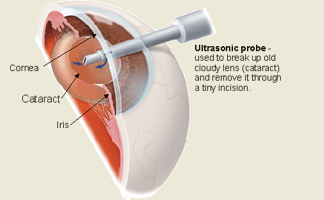
Cataract surgery has witnessed much advancement, from using general anesthesia to local anaesthesia where puncture was made behind the eyeball, and now, topical anaesthesia (eye drops only). In the past, cataract surgery was performed under general anaesthesia, which meant patients were made to stay back at the hospital for a long while. Later, under local anaesthesia, a puncture was made by injecting anaesthetic just behind the eyeball.
This procedure was, however, not entirely free of risk. These days, eye drop anaesthesia is used and a patient is sedated using an intravenous drip (IV).
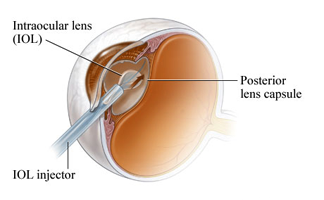
Phacoemulsification or ultrasound technology is used to remove a cataract.
A probe is inserted through a 2.5 mm opening created with a specific self-sealing technique. This places the incision into the cornea. Most patients prefer this technique combined with the soft foldable lens implant.Ultrasound is then used to gently emulsify (break up) the cloudy lens into tiny pieces, that can then be removed through the tip of the probe
(or ‘phaco’) instead of through a wide incision. A special lens can then be implanted through the incision.
Advantages of Topical Anaesthesia..
- The patient is more comfortable. It also eliminates any anxiety
the patient may have about a needle being inserted into
the eyeball. - Visual recovery begins almost immediately since the eye
muscles aren't paralyzed as in the case of local block
anaesthesia. - It eliminates potential complications such as perforation
of the eye, haemorrhages or damage to the optic nerve. - It removes the chance of a relatively dangerous
anaesthesia-induced allergic reaction. - It eliminates the potential for post-operative headaches
caused by conventional blocks. - It eliminates the need for an eye patch
- It is faster.
Advantages of No-Stitch Incision Surgery..
- There is no placement or removal of sutures.
- It may be performed under local or topical anaesthesia.
- An eye patch is not required when performed under topical anaesthesia.
- The incision is bloodless.
- It reduces post-operative restrictions
- It improves post-operative vision and minimizes post-operative astigmatism.
FAQ
Are there other types of cataract?
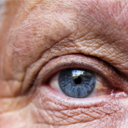
Yes.
Although most cataracts are related to aging, there are other types of cataract:
Secondary cataract:
Cataracts can form after surgery for other eye problems, such as glaucoma.Cataracts also can develop in people who have other health problems, such as diabetes. Cataracts are sometimes linked to steroid use.
Traumatic cataract:
Cataracts can develop after an eye injury, sometimes years later.Congenital cataract:
Some babies are born with cataracts or develop them in childhood,often in both eyes.These cataracts may be so small that they do not affect vision. If they do, the lenses may need to be removed.Radiation cataract:
Cataracts can develop after exposure to some types of radiation.Who is at risk for cataract?
Personal behavior such as smoking and alcohol use.
The environment such as prolonged exposure to sunlight.
What can I do to protect my vision?
If you smoke, stop.
If you are age 60 or older, you should have a comprehensive dilated eye exam at least once every two years. In addition to cataract, your eye care professional can check for signs of age-related macular degeneration, glaucoma, and other vision disorders.
Early treatment for many eye diseases may save your sight.
Can Sight Loss be Prevented?
Cataracts no longer need to be ripe for removal.
Am I a Candidate for the latest techniques?
patients can undergo traditional techniques and expect to do well. We offer a wide variety of techniques to suit every budget and every patient.

